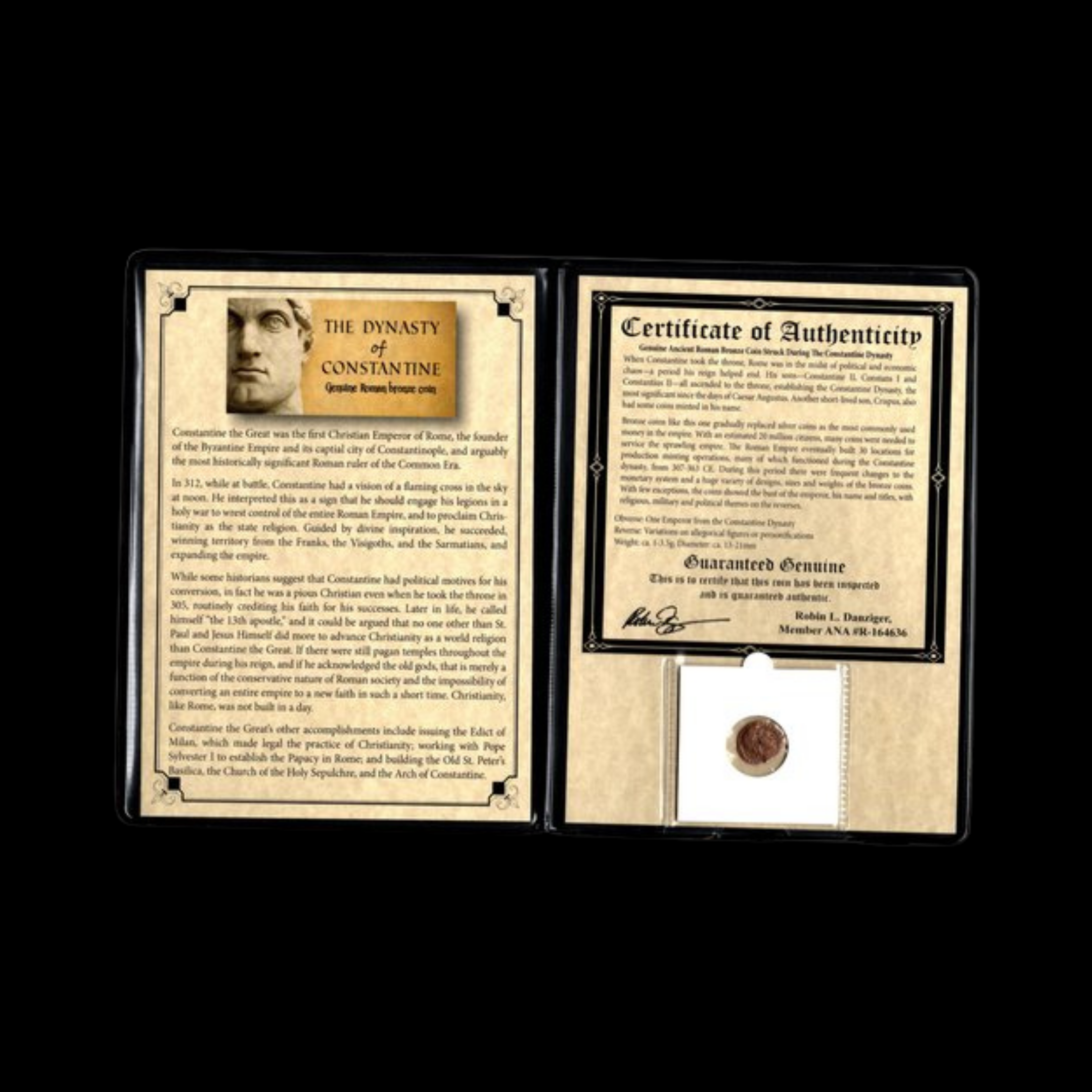 Image 1 of 6
Image 1 of 6

 Image 2 of 6
Image 2 of 6

 Image 3 of 6
Image 3 of 6

 Image 4 of 6
Image 4 of 6

 Image 5 of 6
Image 5 of 6

 Image 6 of 6
Image 6 of 6







Roman Bronze Coin – Constantine the Great (about 1,685 years old) – ‘Hand of God’ Issue Showing the Emperor’s Ascent to Heaven – NGC Certified
The coins shown are representative examples of the grade and type, but not the actual specimens for sale. For details on NGC’s grading standards and definitions, please refer to our NGC Grading page.
This bronze coin is a posthumous issue commemorating Emperor Constantine I "The Great" minted shortly after his death in 337 CE. The distinctive "Manus Dei" (Hand of God) design represents the Christian symbolism that became increasingly prominent on Roman coinage following Constantine's embrace of Christianity, showing his deified hand or his soul being taken to heaven by the hand of God.
Coin Description:
Front side: Veiled portrait of Constantine I facing right, depicting him in a posthumous, deified state, with his name and imperial titles in Latin around the edge.
Back side: Features the "Manus Dei" design showing a hand reaching down from heaven, likely with Constantine in a chariot ascending to heaven or being welcomed into heaven, symbolizing his apotheosis.
Technical Details:
Bronze alloy composition
Denomination: Likely an AE3 or AE4 small bronze coin
Weight: Approximately 1.5-3 grams
Diameter: Approximately 15-20 mm
NGC Certified for authentication and preservation
Minted between 337-340 CE (posthumous issue)
Condition as specified by NGC certification
Historical Significance: This posthumous issue honors Constantine I, arguably the most transformative emperor in Roman history. His legalization of Christianity through the Edict of Milan (313 CE) fundamentally altered the religious landscape of the Western world. By establishing Constantinople (modern Istanbul, Turkey) as a new imperial capital, he created the foundation for what would become the Byzantine Empire, which would survive for another thousand years. This "Manus Dei" coin design represents a fascinating blend of traditional Roman imperial apotheosis (deification of emperors) with emerging Christian symbolism, reflecting the transitional religious period during which the Roman Empire gradually transformed from a pagan to a Christian state.
The coins shown are representative examples of the grade and type, but not the actual specimens for sale. For details on NGC’s grading standards and definitions, please refer to our NGC Grading page.
This bronze coin is a posthumous issue commemorating Emperor Constantine I "The Great" minted shortly after his death in 337 CE. The distinctive "Manus Dei" (Hand of God) design represents the Christian symbolism that became increasingly prominent on Roman coinage following Constantine's embrace of Christianity, showing his deified hand or his soul being taken to heaven by the hand of God.
Coin Description:
Front side: Veiled portrait of Constantine I facing right, depicting him in a posthumous, deified state, with his name and imperial titles in Latin around the edge.
Back side: Features the "Manus Dei" design showing a hand reaching down from heaven, likely with Constantine in a chariot ascending to heaven or being welcomed into heaven, symbolizing his apotheosis.
Technical Details:
Bronze alloy composition
Denomination: Likely an AE3 or AE4 small bronze coin
Weight: Approximately 1.5-3 grams
Diameter: Approximately 15-20 mm
NGC Certified for authentication and preservation
Minted between 337-340 CE (posthumous issue)
Condition as specified by NGC certification
Historical Significance: This posthumous issue honors Constantine I, arguably the most transformative emperor in Roman history. His legalization of Christianity through the Edict of Milan (313 CE) fundamentally altered the religious landscape of the Western world. By establishing Constantinople (modern Istanbul, Turkey) as a new imperial capital, he created the foundation for what would become the Byzantine Empire, which would survive for another thousand years. This "Manus Dei" coin design represents a fascinating blend of traditional Roman imperial apotheosis (deification of emperors) with emerging Christian symbolism, reflecting the transitional religious period during which the Roman Empire gradually transformed from a pagan to a Christian state.


























